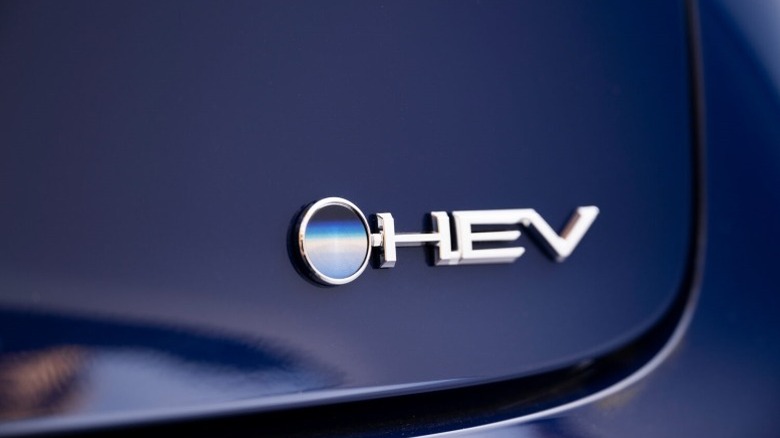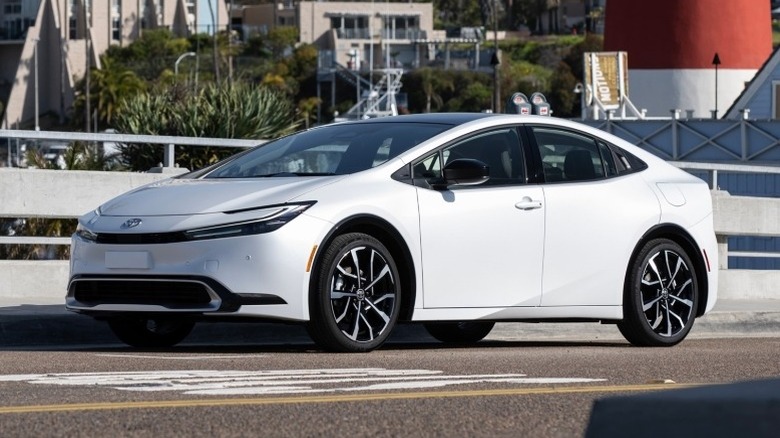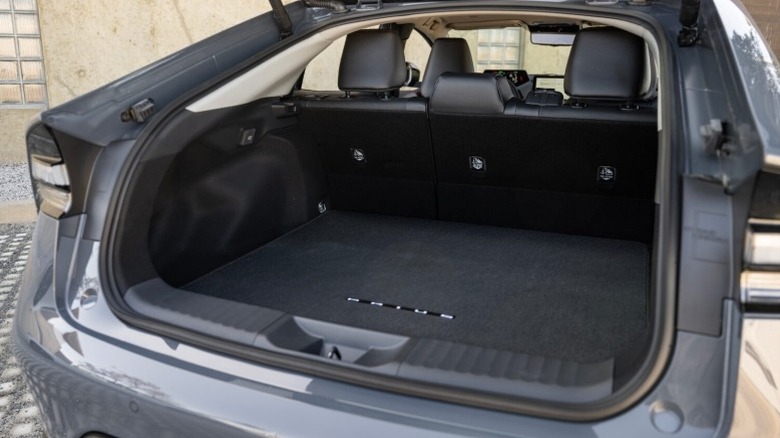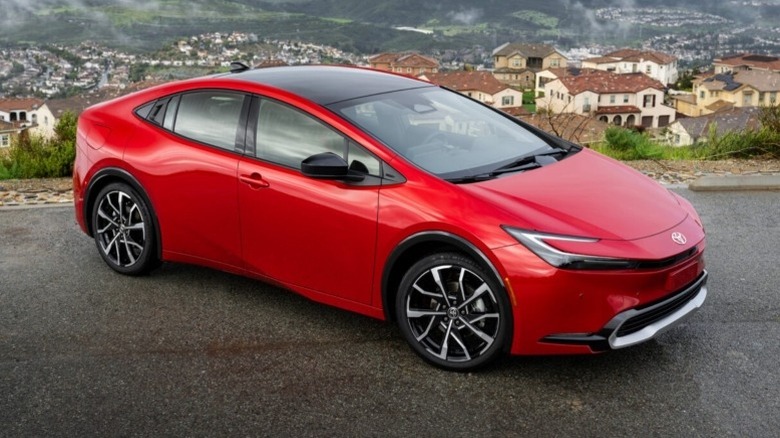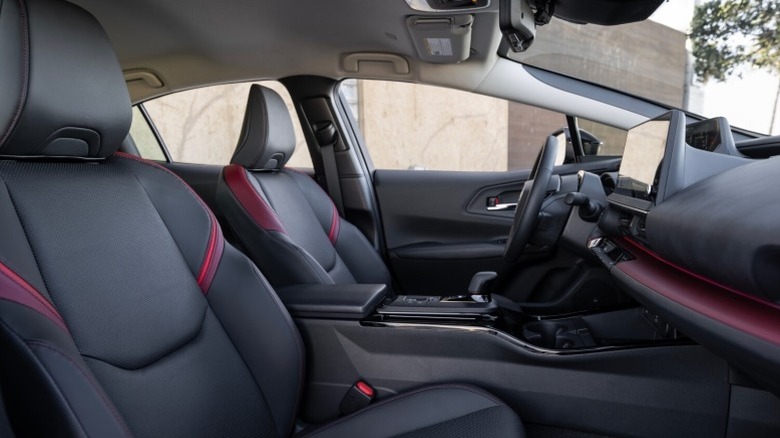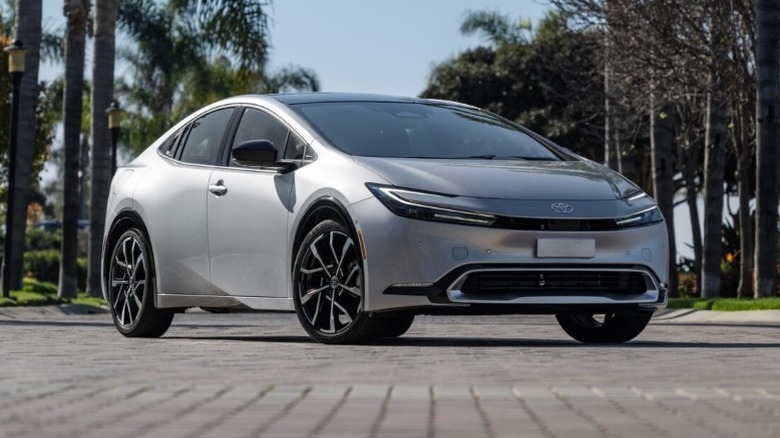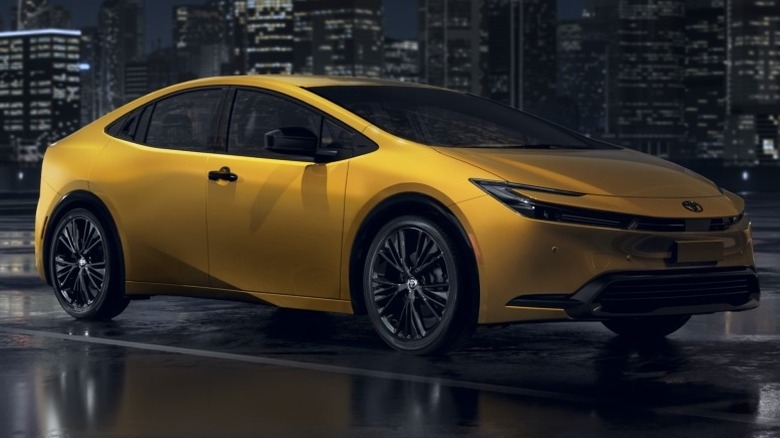Toyota Prius Vs. Prius Prime: How Do The Two Hybrids Compare?
If you're in the market for a reliable, efficient compact car, you're probably looking at the Toyota Prius and Prius Prime (now named — or, rather, renamed – Prius Plug-in Hybrid). Both offer reasonably comfortable seating for five, nice interior amenities, a generous list of safety features, great fuel economy, and a similarly tuned chassis. But they differ, too, with the key difference being that the standard Prius is a parallel hybrid car, whereas the Prius Plug-in Hybrid is, well, a plug-in hybrid.
The Prius was where it all started. The compact car debuted in October 1997, becoming the first production car with a hybrid drivetrain. The original model remained until 2003 before making way for the second Prius generation, which lasted through 2009, when Toyota debuted the third-generation Prius. Three years later, in 2012, the first-generation Prius plug-in launched as the "Toyota Prius Plug-in Hybrid," renamed the Toyota Prius Prime when the second-generation model was introduced for 2017.
Now, for the 2025 model — part of the third generation that began in 2023 – Toyota has dropped the "Prime" suffix, returning to the previous "Prius Plug-in Hybrid" name. The Toyota Prius, meanwhile, is currently in its fifth generation, also introduced for 2023. Here's a side-by-side comparison in terms of their dimensions, performance, interior features, tech, and prices.
What's the difference between a parallel and a plug-in hybrid?
The primary difference between a parallel and a plug-in hybrid car is the battery size and how the batteries are recharged. Put simply, a parallel or self-charging hybrid system combines an internal combustion engine, small battery pack, and electric motor. The system uses regenerative braking to capture energy during braking and convert that energy into electricity to charge the battery. With this, a full hybrid car such as the Prius can operate like an EV at low speeds by running entirely on battery power for short distances.
In a parallel hybrid car, the gasoline engine shares power duties with the electric motor to accelerate the car, and can run independently of the electric motors. While you don't need to plug a parallel hybrid car in to charge it, a plug-in hybrid vehicle is designed to use a power plug to recharge its battery, much like pure electric vehicles do. A plug-in hybrid is similar to a parallel hybrid in that it features an internal combustion engine, electric motor, and a battery. But because it has more powerful electric motors and its battery is usually larger than a parallel hybrid's, a plug-in hybrid car can drive on electric power alone for extended periods.
The Toyota Prius and Prius Plug-in Hybrid are based on the same Toyota GA-C platform
The current Toyota Prius Plug-in Hybrid and standard Prius are both underpinned by the same GA-C unibody structure used by Toyota's other compact cars, including the Corolla, the GR Corolla turbo hatchback, the Corolla Cross, and even the Lexus UX. Both compact hybrids also share an Independent MacPherson strut suspension with stabilizer bars at the front, as well as a multi-link rear suspension with stabilizer bars.
The similarities extend to their dimensions too, as the two ride on a similarly sized 108.3-inch wheelbase and share the same 181.1-inch length and 55.9-inch height in their base trims (LE for the Prius and SE for the Prius Plug-in Hybrid). The Prius is a tenth of an inch wider than the Prius Plug-in Hybrid in the base spec, however, with its width coming in at 70.2 inches compared to 70.1 for the Prius Plug-in Hybrid.
Beyond the base models, the Prius and Prius Plug-in Hybrid are identical in their exterior dimensions across all the higher trims, meaning 181.1 inches of length, 70.2 inches of width, and 56.3 inches height. Ground clearance is also similar, with the base models having 5.6 inches, while the higher models boast 6.0 inches.
The standard Prius has more cargo space with all seats in place
The Prius is the bigger of the two hybrids in terms of cargo space. In base LE spec, it offers 23.8 cubic feet of room without sacrificing passenger space. That's 3.5 cubic feet more room than other Prius trims such as the XLE, Nightshade Edition, and Limited, which have 20.3 cubic feet of carrying capacity. That's the same amount of space as the Plug-in Hybrid's, which measures 20.3 cubic feet across all three trims of SE, XSE, and XSE Premium.
In the passenger compartment, the standard Prius offers four-fifths of an inch more front-seat legroom than the Plug-in Hybrid's 42.4 inches. The Plug-in Hybrid does make up for that loss by offering more legroom in back — 35.9 inches versus 34.8 inches for the standard Prius. For headroom, you get 38 inches up front and 36.4 inches in the rear with either model, with the exception of 37.5 inches in front for the Plug-in Hybrid's XSE Premium trim.
The Plug-in Hybrid is more powerful than the standard Prius
While the Prius and Prius Plug-in Hybrid both use a 2.0-liter four-cylinder gasoline engine, the Plug-In is faster and more powerful due to its larger battery pack and more potent electric motors. Specifically, the Plug-in Hybrid's gas engine pairs with two electric motors and a 13.6-kWh lithium-ion battery to deliver 220 total horsepower and 139 pound-feet of torque to the front wheels via a continuously variable automatic. Alone, the gasoline engine makes 160 horses, which means the electric motors are responsible for 60.
In Car and Driver's performance testing, the Plug-in managed zero-to-60 mph in 6.7 seconds when both the gas and electric motors were used — an additional second over the Toyota-estimated 6.6-second time. On EV power, the time climbs to 11.2 seconds. When fully charged, the Plug-in's battery can cover up to 44 miles in all-electric mode before the gas engine kicks in.
For a front-wheel-drive Prius, Car and Driver gave the zero-to-60 mph time as 7.1 seconds, courtesy of the 2.0-liter four-cylinder engine and an electric motor that together generate 194 total horsepower and 139 lb-ft of torque. All-wheel-drive Prius models bump the horsepower to 196 horsepower from the same 2.0-liter four-cylinder engine and two electric motors. So, while it may not be as powerful as its sibling, the standard Toyota Prius does one-up the Plug-in by offering an available AWD system while the Plug-in is front-drive only.
The Prius is more efficient than the Plug-in as a conventional hybrid
The standard Prius offers better fuel economy than the Plug-in — 57 mpg combined city-highway. This applies to the base-spec Prius LE trim with front-wheel drive; all-wheel-drive LE trims are good for 54 mpg combined. If you opt for the Prius XLE, Limited, or Nightshade Edition with front-wheel drive, that average dips even further, to 52 mpg. In all-wheel-drive, the Prius XLE, Limited, and Nightshade Edition deliver an EPA-certified rating of 49 mpg combined.
This means the Prius LE is more efficient than the base Plug-in SE, given the Plug-in's average economy figure of 52 mpg. The Plug-in Hybrid XSE and XSE Premium trims get just 48 mpg when using gas alone. However, the Plug-in Hybrid's potential for fuel saving increases significantly when you factor in the pure electric range of 44 miles, ensured by its larger battery pack. When running on battery power, the Plug-in SE makes a whopping 127 miles-per-gallon equivalent, while XSE and XSE Premium trims earn only 114 mpge.
And because the Plug-in Hybrid is just that, you can plug it in to charge the battery from another power supply such as a 120-volt home outlet or public charging station. The regular Prius, on the other hand, self-charges only through the gas engine or regenerative braking — which the Prius Plug-in Hybrid can also do.
The Prius Plug-in Hybrid has slightly more standard interior features
The Prius Plug-in Hybrid and standard Prius are both reasonably equipped in the base trims. However, the Plug-in offers just that little bit extra. The Plug-in Hybrid SE comes standard with a climate-control system with pollen filtration, push-button start, heated steering wheel, cloth-trimmed seats, six-way manually adjustable front seats, and 60/40 split fold-down rear seats. While the Prius LE has many of the same features, it doesn't offer a heated steering wheel, for example.
Tech-wise, the Plug-in and regular Prius both have an 8-inch touchscreen infotainment system, a digital gauge cluster, wireless Apple CarPlay and Android Auto, Wi-Fi hotspot, six USB-C ports, and six-speaker audio system. With regard to safety tech, both cars come standard with the Toyota Safety Sense 3.0, which bundles forward collision warning, forward automatic emergency braking, pedestrian detection, adaptive cruise control, lane-departure warning, lane-trace assist, and traffic-sign recognition, among other things.
The Prius Plug-in Hybrid costs $5,025 more than the standard Toyota Prius
Suggested prices for the 2025 Toyota Plug-in Hybrid start at $33,375 for the base-spec SE trim. That's $5,025 more than the entry-level Prius LE, which could be had for $28,350. If you are considering the Prius LE AWD, the difference drops to $3,625, given the LE AWD's $29,750 starting price. Stepping up in trims to the midrange Plug-in XSE will set you back $36,625, which, again, is $4,830 higher than a front-drive Prius XLE ($31,795) or $3,430 more than a Prius XLE AWD (which begins at $33,195).
You'll need far deeper pockets, though, if you're looking to buy from the higher-end of Toyota's hybrid cars. The range-topping Prius Plug-in Hybrid XSE Premium costs significantly more at $40,070, meaning it would cost you $7,510 less to get a front-drive Prius Nightshade Edition or $6,110 if you want the $33,960 Prius Nightshade Edition AWD. The Plug-in XSE Premium's sticker price is also $4,705 steeper than the top-level Prius Limited FWD (starts from $35,365) or $3,305 if you're considering the $36,765 Limited AWD.
Toyota Prius or Prius Plug-in Hybrid: Which should you buy?
The head-turning Toyota Prius and Prius Plug-in Hybrid are both great hybrids with lots of equipment, good fuel economy, and reasonable comfort. However, the Toyota Prius takes the crown if you take into account its cheaper starting price and more generous cargo space. If you frequently encounter wet, muddy, or snowy conditions, you'll also appreciate that the standard Prius is optionally available with all-wheel drive, which the Plug-in Hybrid lacks. When specified, the system can deliver the traction necessary to power you safely through muddy terrain, icy roads, or snow-covered landscapes that might prove too challenging for a front-drive vehicle.
That being said, the Prius Plug-in Hybrid does have the edge in areas like performance and long-term fuel economy. It makes 24 horsepower more than the most potent Prius model at 220 hp. And with data suggesting the average U.S. driver only covers about 37 miles a day, there's potentially greater fuel savings to be had with the Prius Plug-in Hybrid, since its 44 miles electric range could be sufficient for your daily commute. In any case, we strongly suggest you evaluate both hybrid cars through test drives to see which one works better for your needs.

